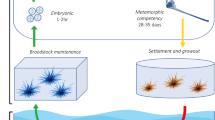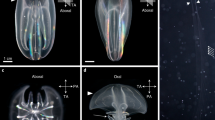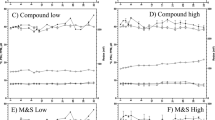Abstract
Over the past 20 years, the starlet sea anemone, Nematostella vectensis, a small estuarine animal, has emerged as a powerful model system for field and laboratory studies of development, evolution, genomics, molecular biology and toxicology. Here we describe how to collect Nematostella, culture it through its entire sexual life cycle and induce regeneration for the production of clonal stocks. In less than 1 h at a suitable field site, a researcher on foot can collect hundreds of individual anemones. In a few months, it is possible to establish a laboratory colony that will be reliable in generating hundreds or thousands of fertilized eggs on a roughly weekly schedule. By inducing regeneration roughly every 2 weeks, in less than 6 months, one can establish a clonal stock consisting of hundreds of genetically identical anemones. These results can be achieved very inexpensively and without specialized equipment.
This is a preview of subscription content, access via your institution
Access options
Subscribe to this journal
Receive 12 print issues and online access
$259.00 per year
only $21.58 per issue
Buy this article
- Purchase on Springer Link
- Instant access to full article PDF
Prices may be subject to local taxes which are calculated during checkout





Similar content being viewed by others

References
Reitzel, A.M., Ryan, J.F. & Tarrant, A.M. Establishing a model organism: a report from the first annual Nematostella meeting. BioEssays 34, 158–161 (2012).
Darling, J.A. et al. Rising starlet: the starlet sea anemone, Nematostella vectensis. BioEssays 27, 211–221 (2005).
Stephenson, T.A. The British Sea Anemones Vol. II. (The Ray Society, 1935).
Hand, C. & Uhlinger, K. The culture, sexual and asexual reproduction, and growth of the sea anemone Nematostella vectensis. Biol. Bull. 182, 169–176 (1992).
Hand, C. & Uhlinger, K.R. Asexual reproduction by transverse fission and some anomalies in the sea anemone Nematostella vectensis. Invert. Biol. 114, 9–18 (1995).
Hand, C. & Uhlinger, K. The unique, widely distributed sea anemone, Nematostella vectensis Stephenson: A review, new facts, and questions. Estuaries 17, 501–508 (1994).
Genikhovich, G. & Technau, U. Induction of spawning in the starlet sea anemone Nematostella vectensis, in vitro fertilization of gametes, and dejellying of zygotes. Cold Spring Harb. Protoc. http://dx.doi.org/10.1101/pdb.prot5281 (2009).
Fritzenwanker, J.H. & Technau, U. Induction of gametogenesis in the basal cnidarian Nematostella vectensis (Anthozoa). Dev. Genes Evol. 212, 99–103 (2002).
Burton, P.M. & Finnerty, J.R. Conserved and novel gene expression between regeneration and asexual fission in Nematostella vectensis. Dev. Genes Evol. 219, 79–87 (2009).
Reitzel, A., Darling, J., Sullivan, J. & Finnerty, J. Global population genetic structure of the starlet anemone Nematostella vectensis: multiple introductions and implications for conservation policy. Biol. Invasions 10, 1197–1213 (2008).
Frank, P.G. & Bleakney, J.S. Asexual reproduction, diet, and anomalies of the anemone Nematostella vectensis in Nova Scotia. Canadian Field Naturalist 92, 259–263 (1978).
Sheader, M., Suwailem, A.M. & Rowe, G.A. The anemone, Nematostella vectensis, in Britain: considerations for conservation management. Aquatic Conserv.: Mar. Freshw. Ecosyst. 7, 13–25 (1997).
Williams, R.B. Nematostella vectensis. in The IUCN Invertebrate Red Data Book 43–46 (International Union for Conservation of Nature and Natural Resources, 1983).
Darling, J.A., Reitzel, A.M. & Finnerty, J.R. Regional population structure of a widely introduced estuarine invertebrate: Nematostella vectensis Stephenson in New England. Mol. Ecol. 13, 2969–2981 (2004).
Reitzel, A. et al. Physiological and developmental responses to temperature by the estuarine sea anemone Nematostella vectensis: evidence for local adaptation to high temperatures. Mar. Ecol. Prog. Ser. http://dx.doi.org/10.3354/meps10282 (2012).
Uhlinger, K.R. Sexual Reproduction and Early Development in the Estuarine Sea Anemone, Nematostella vectensis Stephenson, 1935. PhD thesis (University of California, Davis, 1997).
Frank, P. & Bleakney, J.S. Histology and sexual reproduction of the anemone Nematostella vectensis Stephenson 1935. J. Nat. Hist. 10, 441–449 (1976).
Sullivan, J.C. et al. Two alleles of NF-κB in the sea anemone Nematostella vectensis are widely dispersed in nature and encode proteins with distinct activities. PloS ONE 4, e7311 (2009).
Reitzel, A.R., Burton, P., Krone, C. & Finnerty, J.R. Comparison of alternate developmental trajectories in the starlet sea anemone Nematostella vectensis (Stephenson): embryogenesis, regeneration, and two forms of asexual fission. Invert. Biol. 126, 99–112 (2007).
Pearson, C.V., Rogers, A.D. & Sheader, M. The genetic structure of the rare lagoonal sea anemone, Nematostella vectensis Stephenson (Cnidaria; Anthozoa) in the United Kingdom based on RAPD analysis. Mol. Ecol. 11, 2285–2293 (2002).
Acknowledgements
This research was supported by National Science Foundation grant no. MCB-0924749 (T.D. Gilmore and J.R.F.). D.J.S. was supported by a Predoctoral Fellowship Award to Promote Diversity in Health-Related Research from the National Institutes of Health (no. F31 GM095289-01). D.J.S. was also supported by a Warren-McLeod Graduate Fellowship in Marine Biology.
Author information
Authors and Affiliations
Contributions
The collection and regeneration protocols were developed by J.R.F. All authors participated in writing the manuscript and optimizing the protocols.
Corresponding author
Ethics declarations
Competing interests
The authors declare no competing financial interests.
Supplementary information
Supplementary Data
Nematostella vectensis collection sites. (PDF 2682 kb)
Supplementary Video 1
Collection of an individual specimen of Nematostella vectensis using a wide-bore transfer pipette. (MOV 1203 kb)
Rights and permissions
About this article
Cite this article
Stefanik, D., Friedman, L. & Finnerty, J. Collecting, rearing, spawning and inducing regeneration of the starlet sea anemone, Nematostella vectensis. Nat Protoc 8, 916–923 (2013). https://doi.org/10.1038/nprot.2013.044
Published:
Issue Date:
DOI: https://doi.org/10.1038/nprot.2013.044
This article is cited by
-
Microbiota mediated plasticity promotes thermal adaptation in the sea anemone Nematostella vectensis
Nature Communications (2022)
-
Novel methods to establish whole-body primary cell cultures for the cnidarians Nematostella vectensis and Pocillopora damicornis
Scientific Reports (2021)
-
Cellular pathways during spawning induction in the starlet sea anemone Nematostella vectensis
Scientific Reports (2021)
-
Mediators of invasions in the sea: life history strategies and dispersal vectors facilitating global sea anemone introductions
Biological Invasions (2020)
-
MAPK signaling is necessary for neurogenesis in Nematostella vectensis
BMC Biology (2016)
Comments
By submitting a comment you agree to abide by our Terms and Community Guidelines. If you find something abusive or that does not comply with our terms or guidelines please flag it as inappropriate.


